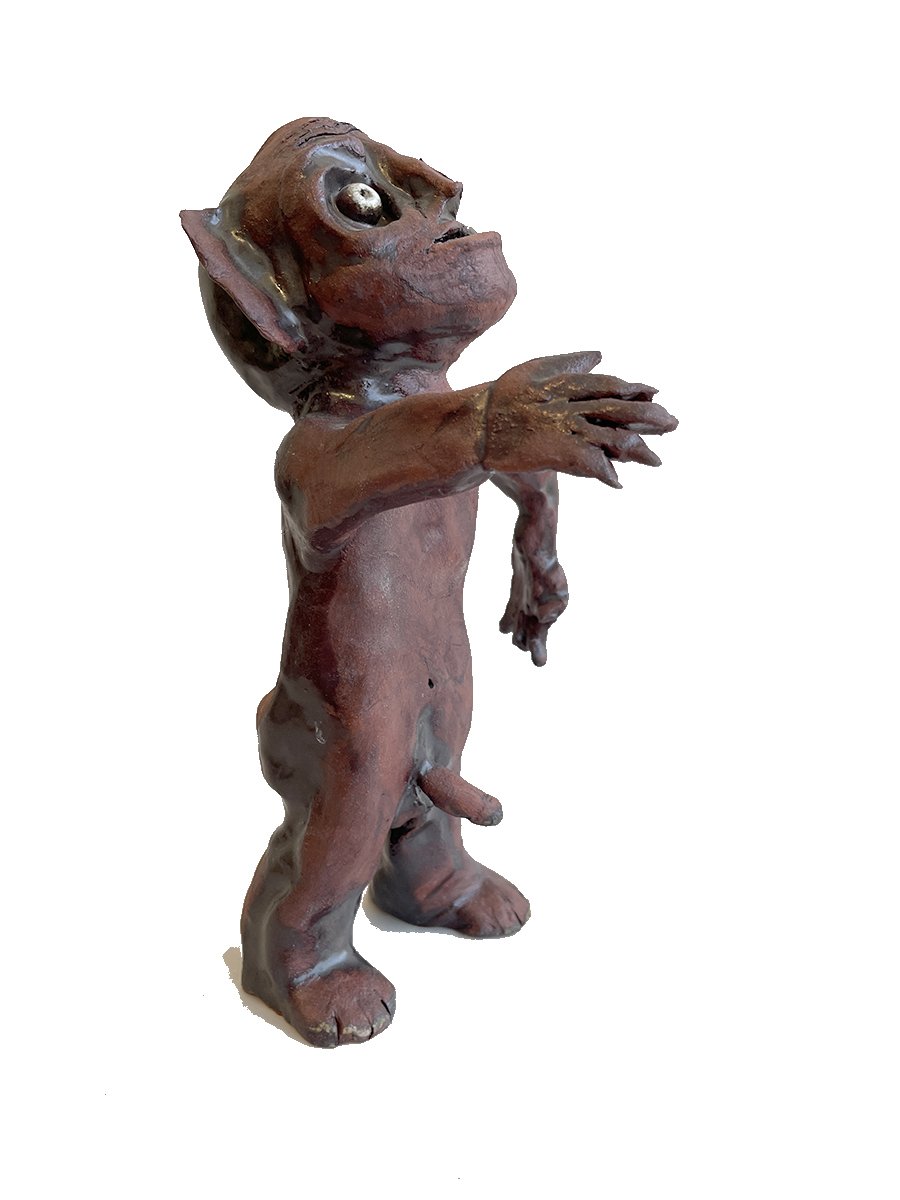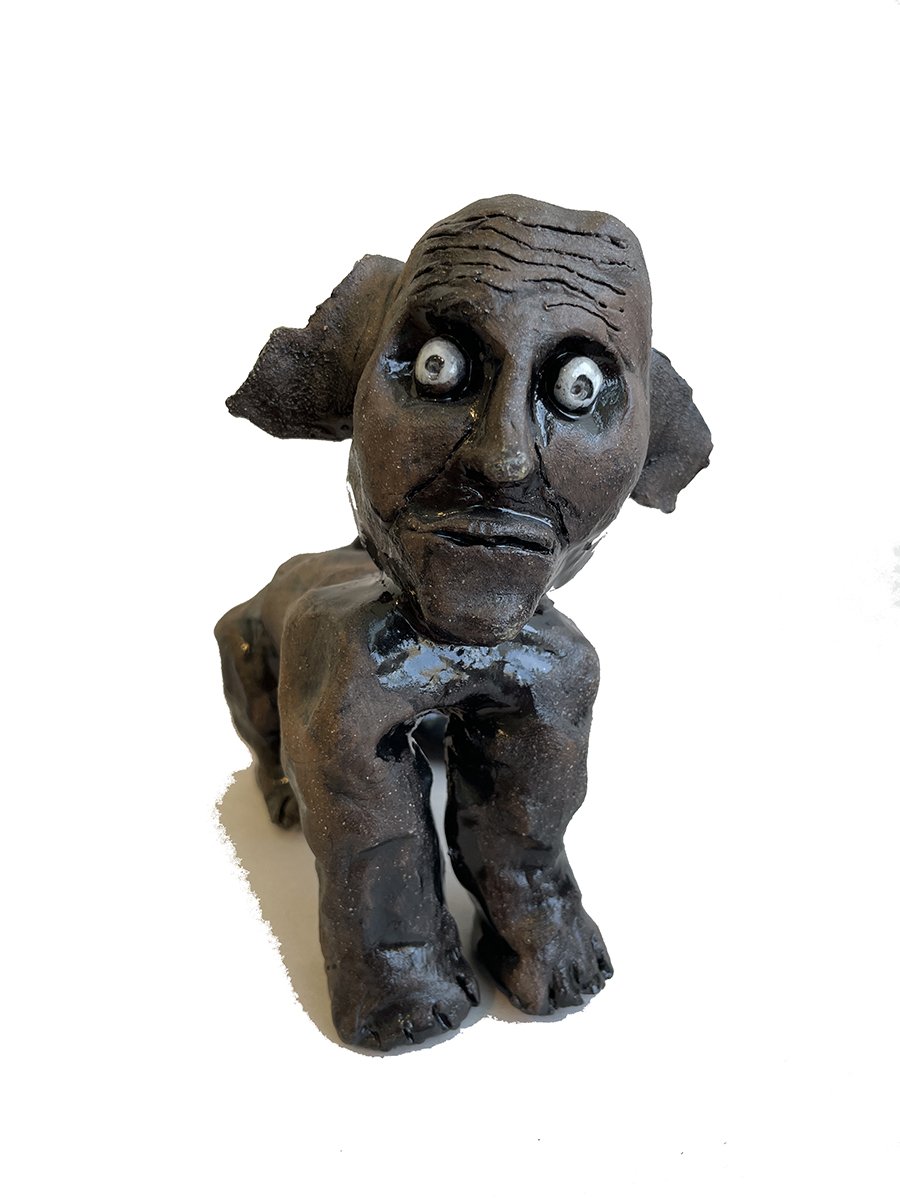
Portfolio
Fallen Creatures Series, 2023
These sculptures began as a series of sketches inspired by John Milton’s seventeenth-century poem Paradise Lost. Milton describes Satan’s fall from heaven with his band of rebel angels as well as the fall of the first humans, Adam and Eve. The ceramic figures I have fashioned out of clay at Hoofprint draw freely and promiscuously from ideas of humans, angels, and animals, and they can be considered in both physical and metaphysical terms. In these figures, I attempt to demonstrate sentient beings with some kind of self-awareness.
“Little Marlon Brando” (2023)
“You Tore My Fucking Heart Out” (2023)
“Philosopher Dog” (2023)
“Self-Portrait” (2023)
“Besties: Stevie Nicks Greets Grampaccino” (2023)
“Sometimes I’m Always Sad” (2023)
“Blue Milton” (2023)
“Cocktail Hour with a Happy Dog” (2023)
“Paulie Walnuts” (2023)
“Red-Eyed Enchantress from the Stone Age” (2023)
“Michigan Dunes” (2023)
18x24” Copper plate etching on Hahnemuhle paper, artist’s proof
From a photograph I took while walking at Warren Dunes State Park in Berrien County, Michigan, on a foggy day in 2015. The locale holds mystery and memory, all piling up since 1980, when I first saw the landscape.
Horus Returns as an English Barrister
(With His Four Sons as Canopic Jars) (2021)
Ceramic sculptures and textile wig
Horus, miraculously conceived by his parents Isis and Osiris, became one of the most powerful sky gods in ancient Egypt. He is usually depicted as a man with the head of a peregrine falcon, or simply as a falcon. (Note: The peregrine falcon thrives as a predator in urban landscapes, including Chicago. When it goes into its hunting dive for smaller birds, it has been clocked at speeds of up to 186 miles per hour, making it not just the fastest bird but indeed the fastest animal on the planet.)
The origin story of Horus’s father Osiris anticipates the plot of Hamlet while also carrying the idea of resurrection. Briefly, Osiris was deceived by his evil brother Set, slain, and his body cut into pieces and scattered throughout Egypt. Osiris’s wife Isis recovered the remains and reassembled them, only to discover that her dead husband had no penis. It had been eaten by a catfish in the Nile River. Isis constructed a magical golden phallus and fastened it to the corpse, and wrapped the whole package up as a mummy. Then she assumed the form of a kite bird and flew over Osiris’s body.
Responding to this daring act of sexual initiative by Isis, even a corpse with a prosthesis was able to come to life. Isis miraculously conceived, and the result was Horus. Osiris took his place as a god in the underworld, while his son rose to great power. But there was still unfinished business. Horus would have to confront his Uncle Set, and after years of putting it off, the two closed in mortal combat. Set managed to poke out one of Horus’s eyes; Horus acquitted himself by ripping off both of Uncle Set’s testicles in a bloody act of payback.
In this sculpture of Horus returned as an English barrister, I have tried to embody the raw power and sexuality of Horus allied with his sky-god status and imperial aspirations. The Four Sons of Horus in their representation by canopic jars used in mummification practice are a vital part of the Horus mythography, and serve as a stark reminder that even gods come burdened with certain limitations. These are the four sons:
Imsety (human) holds the liver.
Duamutef (jackal) holds the spleen and stomach.
Hapi (baboon) holds the lungs.
Qebehsenuef (falcon) holds the intestines.
Thanks to Liz Born of Hoofprint for her collaboration on this ceramics project.
Mariolatry (2016-2020)
Mixed media installation: wood, metal, candles, pill containers
In 2016 a retired social worker and family therapist named Mary Classen Born died in a Chicago nursing facility after a long struggle with Huntington’s disease, an incurable neurological illness. She was sixty, her mind and body wasted by a condition that is frequently described as a mash-up of Alzheimer’s, ALS, and Parkinson’s.
The image of Mary screen printed on the candles is from a photo I took of her on a sailboat off the coast of Jacmel, Haiti in January 1989, while on vacation. She was about to turn 33. She was diagnosed with Huntington’s seven years later, in 1996, and began the fight that would occupy her for the remaining twenty years of her life. Ten days before she died, I asked her how she was doing. She weighed just over seventy pounds. She paused and said in a hoarse but clear voice: “I’m doing pretty well.”
“Late Capitalism: Spiegel Warehouse” (2021)
18x24’’ Copper plate etching on Hahnemuhle paper, edition of 6
Founded in 1865 by the son of a German rabbi and a younger brother of Union Army Colonel Marcus M. Spiegel, the Spiegel company built its brand by merchandising and selling furniture, clothing, and other consumer goods. It endured several boom-and-bust cycles, but by the early 1980s was a leader in the luxury consumer catalog business, with a major warehousing and order fulfillment operation located in the Clock Tower Industrial Park complex in Chicago. It went into decline after the 1990s, and a series of unfortunate business partnerships, changes in ownership, and bankruptcy marked the beginning of the end. Its website was shut down completely in early 2020.
The once-mighty warehousing operation is now a vast emptiness in the Clock Tower Industrial Park. When I first considered the emptiness of the space, photographed it, then sketched, and finally etched the copper plate, the last four lines of Percy Shelley’s poem “Ozymandias” came to mind:
‘”Look on my works, ye mighty, and despair!”
Nothing beside remains. Round the decay
Of that colossal wreck, boundless and bare,
The lone and level sands stretch far away.’





















